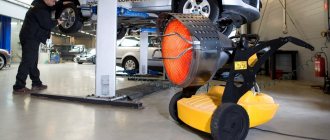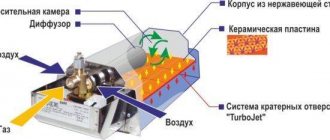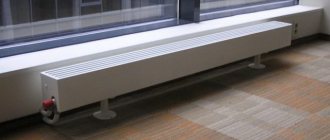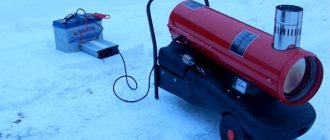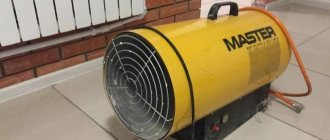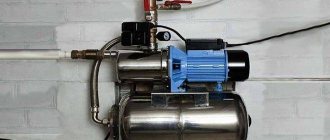The issue of heating garages and utility rooms is relevant in the winter conditions of the northern regions. Demand creates supply, which is why the number of heating devices on the market is very large.
To choose the right heaters for a garage, you need to understand the principle of their operation, evaluate their efficiency, safety and the ability to solve the problem.
We have prepared an overview of the most popular solutions, outlined the pros and cons of different models, and also listed the basic rules for their operation. A step-by-step calculation of the heater power will help you choose the optimal heating device for the garage.
Which heater is the most energy efficient?
Before the start of the heating season, it is worth considering in advance which equipment will be optimal for your home.
There are several types of heaters:
- Electric (convector).
- Infrared.
- Micathermic.
- Air conditioner.
- Ceramic plate (panel).
Electric heater in the interior
Electric convector
Its operating principle is similar to that of an oil cooler. Air circulates through the heating element. The heated air rises and, after cooling, falls to reheat.
The most popular are Atlantic models. The power of convectors varies from 0.5 to 2.5 kW. To heat a room of 20 sq. m. it will take 4-5 hours.
Electric convector Atlantic
Infrared heater
Oil and electrical products have been replaced by a new type of heating equipment. The energy consumption of such equipment is significantly less. A quartz emitter is a heating element that heats up and transfers heat to nearby objects. Such equipment does not heat the air. It is suitable for quickly heating a room. But it is not able to efficiently heat the entire house for a long time.
The infrared device can be installed outdoors. The equipment can be mounted to the ceiling or installed on legs. For heating a room up to 20 square meters. m. it will take 2 hours.
Popular models: Eko, Saturn, Beko, etc. The product consumes an average of 90 W per sq.m.
Micathermic heater
This product is distinguished by its economy and efficiency. It was developed using new technology and was released not so long ago. The equipment was previously used in astronautics and medical institutions. The equipment can be installed on the ceiling or wall.
A micathermic heater heats up efficiently because it has several plates that are coated with mica. It is safe as it does not get hot. Objects around the device heat up evenly.
There is one drawback in the equipment - high cost. A high-quality model is a product from Polaris with a power of 1.8 kW.
Micathermic heater Polaris
Air conditioner
The air conditioner is distinguished by its efficiency. Often used to heat a country house. The equipment consists of an indoor and outdoor unit. Heating a room is different from other heating devices.
The air conditioner is powered by a heat pump. It takes warm air inside the room using a heat exchanger. Therefore, even at negative temperatures, the air heats up and enters the house already warm. Freon is used for heating. Under the influence of pressure, the gas passes through the indoor unit in the heat exchanger and heats up to 80 degrees. After this, the freon goes to the outside and returns to the gas under low pressure. After boiling, it flows again into the indoor unit.
From 2 to 5 kW of electricity is consumed per hour, depending on the model. Air conditioners can heat houses even with a large area. Popular models: Samsung, Daikin and LG.
Ceramic panel
Such equipment is also considered economical. The device looks like a ceramic plate. It works on the principle of long-wave infrared radiation. Excellent for different interiors, as it has a steel heat-conducting box. The panel can be installed on a wall or ceiling.
To calculate electricity consumption, it is necessary to take into account the dimensions of the device. On average, the panel consumes 0.2-2.5 kW per hour. Room 20 sq. m. can fully heat up after 2 hours.
Gas heat generators
As equipment for heating a garage, gas heaters are somewhat inferior in popularity to diesel heaters, since connecting a garage building to a natural gas pipeline requires developing a project, and using bottled propane or butane is much more expensive. However, in regions with an average length of the heating season, gas heaters are used in garage buildings quite often.
Heating a garage with a gas heater using bottled propane
Gas heaters are divided into infrared and convection heaters. In both types of units, heat is generated by burning gas, but the devices differ in the way they transfer thermal energy.
From the perspective of ease of use in the garage, let’s look at examples of compact units.
Infrared gas heater BALLU BIGH-3 —
An example of a modern energy-saving heating device with the functionality and efficiency required for a garage.
The device is connected through a reducer to a cylinder with propane or butane and sent to the current zone.
After igniting the burner, the ceramic panel, which emits infrared waves, is heated. Infrared radiation heats the surfaces of objects located in the path of propagation, and then the heated interior releases heat into the air in the room.
*
The model is convenient for local directed heating of areas and objects, which is convenient when performing car repairs in the garage. In addition, the adjustable stand allows you to direct the radiation upward and use the device to heat water or cook food.
Main characteristics:
- ignition - manual;
- fuel – propane, butane;
- heat release power – 3 kW (max);
- heated area – up to 30 m2;
- fuel consumption – up to 200 ml/h;
- heater dimensions – 22.5x21.5x22.1 cm;
- weight when filled is 2.2 kg.
Advantages of the model:
- compactness;
- efficiency;
- high-quality paint and varnish coating of the body;
- Class A ceramic emitter of protected design.
Important! Sellers of BALLU BIGH-3 present the heating panel as not subject to deformation from contact with water, but the degree of this resistance is uncertain, therefore, in a garage where car washing is practiced, this IR heater should not come into contact with moisture.
Gas convectors operate on a different principle - the gas burning in the device heats a metal heat exchanger plate, which, in contact with the room air, initiates the formation of convective flows. Gas combustion occurs in the unit body, isolated from the heated volume, and combustion products are discharged outside through a coaxial or conventional chimney.
Due to the removal of combustion products to the street, heat loss when heating with such a device is significant, therefore, to ensure sufficient heat transfer, the heat exchangers of convectors have a much larger area than the heating panels of infrared gas heaters.
Cylinder-powered convection heater
The operation of gas convectors requires significant gas consumption, so they are rarely used for heating garages. In addition, these heaters come into operation slowly, but in a garage the effect of the unit should be quick.
Important! When equipping a garage with a gas convector with an open combustion chamber, the room must be provided with ventilation with three air changes within an hour.
How to calculate the efficiency of heaters
The most economical equipment includes infrared designs. Their power is comparable to traditional water heating, but energy costs are lower. At the same time, the room is quickly heated, which also contributes to savings.
Convectors cannot be classified as the most economical products, but when using thermostats, these indicators improve noticeably. When using them, minimal heat losses are recorded, since there is no need to heat the water.
The table shows the standard calculation of electric heaters
Using energy-efficient heaters, you can create efficient heating systems. To reduce energy consumption by heaters, the following measures are taken:
- the structure is covered with a second layer of brick with thermal insulation;
- windows and doors are replaced with more insulated models;
- the attic is insulated;
- Accurate thermostats are installed.
If heat losses are reduced, the use of electrical equipment will become more economical.
Advantages and disadvantages
The advantages of gas heaters for garages powered by a separate cylinder are:
- compactness and mobility;
- low cost of the equipment itself and fuel for it;
- availability of energy sources;
- environmental friendliness (no combustion waste);
- ease of operation;
- long service life (15–20 years);
- speed of heating the room.
The operational safety of this heating method is beyond doubt if the necessary precautions are taken when using gas, which involve organizing effective ventilation (forced or natural).
The danger of an explosion of a gas mixture can be considered a disadvantage of the units under consideration only if the rules of their operation are violated.
Infrared heaters for home and garden
Infrared heating devices, which recently appeared on the market, are very quickly gaining popularity. They do not have most of the disadvantages characteristic of other models of electric heaters. These economical devices, just like other heaters, can be of several types - wall-mounted, floor-mounted, ceiling-mounted.
In addition to such valuable quality of infrared heaters as heating objects, furniture and walls, rather than air, they also have the following:
- the ability to quickly warm up the room;
- Fire safety;
- during their operation, the air in the room does not dry out;
- noiselessness;
- devices can be mounted on any plane - walls, floors, ceilings;
- low power consumption.
Infrared heating devices can be with ceramic panels or micathermic, and are the most economical heaters for the home. The effectiveness of micathermic devices is associated with the presence of non-metallic plates coated with mica. These devices easily heat objects located at a considerable distance from them, and remain cold, which characterizes them as quite safe. The price of these heaters is much higher than other types. But it is justified by their compactness, installation capabilities in various places, and ease of rearrangement.
Modern ceramic heating devices operate very efficiently. Many buyers recognize them as the best heaters for the home.
Due to the high heat transfer of ceramic heaters, they do not consume much electricity and operate as follows:
- based on convection, when flows of cold air pass through the heating element and move further, thereby increasing the air temperature in the room;
- using infrared radiation, which heats not only all objects in the room, but also the room itself.
The most relevant, economically, is the ceramic panel. Externally, the heater resembles a stove. The heating panel is hidden in a steel box, which has energy-saving and heat-conducting properties.
Many manufacturers have begun producing heating devices with combined infrared-convective heating of the room. Due to the synergistic effect of double heating, such devices can easily and quickly create comfortable conditions for a person not only in a city apartment, living rooms of a country house or country house, but also in utility rooms not intended for living.
Characteristics of gas heating in the garage
Heating a garage using gas from the main pipeline is economical. The fuel burns completely, so it does not harm the environment. But this method is not available to every owner.
Those who want to realize this opportunity should pay attention to some nuances:
- The acquisition and installation of equipment is much more expensive compared to electrical equipment;
- It is prohibited to assemble and connect gas heating elements without a specialist; this should be done by professional gas workers in order to reduce the risk of an explosion, since the danger threatens not only material property, but also human life.
Garage Installed System
These are the main distinguishing features of gas fuel. With electrical equipment, it’s the other way around – the purchase is much cheaper, but the cost of paying electricity bills is higher.
If we talk about heating with gas in a garage, then most often this means installing a boiler. It connects to the water network. But there are other methods. The boiler can only be installed if the garage is located next to the house, when it is possible to extend a line into it from the home system. Otherwise, operating costs will be too high.
The fastest possible heating - gas generators, convectors. These devices operate using natural gas - methane, or it is a propane boiler for heating the garage. The latter is a kind of electric heat gun. The heat generator heats up the air in an instant; it can be installed almost anywhere due to its compactness. But for operation, in addition to gas, current is required. Electricity makes the fan rotate and the control panel operate.
Garage boilers have been used for a relatively long time, their work has been tested over the years
The system can be formed so that the coolant circulates by gravity in the pipes - this is important for buildings located separately. The pump increases electricity consumption
The system itself is a closed circuit - it includes a boiler, radiators, and pipes.
As a rule, two types of boilers are used for garages:
- capacitor;
- ordinary.
Capacitor type
Ordinary ones release steam from combustion through the chimney. But some of the heat disappears with it. Condenser devices do not allow steam to escape; they condense it, releasing heat again, giving it to water. This reduces fuel consumption.
Which heaters are better for home and apartment
The choice usually comes down to four main options:
- Oil.
- Convector.
- Infrared.
- Fan heater.
Convectors and fan heaters
They quickly heat the air, mix the flows, uniformly warming the room. They are safe and durable, the body is not hot, can be attached to the wall and placed on the floor, compact and lightweight.
Fan heaters make a particularly loud noise, but they are the smallest and are easy to carry and move from place to place.
However, some may not like the constant noise of the fan and strong air movement. In addition, in order for the room to be warm, the device must be constantly running. It does not accumulate heat in the body and when turned off, heat transfer immediately stops.
Fan heater
If a person with allergies and pulmonary diseases lives in the house, it is better not to buy a fan heater. But for a children's room, a convector is preferable because it is the safest device.
Infrared heater
“House sun,” as it is sometimes called, instantly heats people and objects located in the area of infrared rays. However, this effect is local, therefore, as a device for heating the entire room, IKO is not very suitable.
In addition, users note that after sleeping in a room where the IR heater was turned on all night, headaches and lethargy appear.
Many owners have found the most successful use by placing the heater near the table to keep warm while working, above the bed (turn it on briefly before bed to warm the bed), in the kitchen, etc.
Infrared heater
Oil radiators
They remain in demand among those for whom air movement around the apartment is a decisive undesirable factor.
They are heavy, cannot be repaired, have a certain shelf life, after which, and if used incorrectly, there is a risk of explosion (it is important that the thermal relay is in good working order, since most accidents occur precisely due to overheating)
But if all norms and rules are observed, it will be able to provide heat instead of a battery. The device takes a long time to heat up, but also takes a long time to cool down. Doesn't generate dust, works silently.
The oil heater body heats up to dangerous temperatures. In addition, it cannot be dropped. Therefore, it is better not to put it in the children's room.
Oil type heater
Design and principle of operation
Just by the name “gas heater” it is easy to understand that gas will be burned inside it or in a special external burner. The simplest version of the heater, in addition to the housing and burner, is equipped with a protective grille. It helps prevent burns and accidents. To regulate the gas supply, a valve and valve are provided. The difference in design is related to how exactly the generated heat is released outside.
In some cases, direct air heating is simply used. In others, a gas burner transfers heat to water or another coolant (although this is more of a boiler than a heater). Still others use infrared heat transfer. Infrared rays are reflected from a special surface (reflector). When these rays hit the surface of various objects, their temperature will increase.
But this is not all the subtleties of a gas heater. The quality of preparation of the gas-air mixture plays a very important role. It is formed inside a special mixer.
Gas
In terms of the cost of energy (natural gas), this is the highest in the garage, but it is accompanied by hidden costs:
- preparation of design and permitting documentation;
- payment for the work of licensed gas equipment installation specialists;
- costs for ventilation and removal of combustion products;
- costs for routine maintenance of the boiler;
- possibly the necessary construction and subsequent maintenance of the chimney.
Alternatively, to heat the garage you can use infrared gas heaters, heating panels, convectors that consume liquefied propane and butane in cylinders - this eliminates the need to go through the authorities, but adds the problem of providing fuel.
Features of gas heating:
- advantages - high level of automation of the heating system, when using natural gas - constant availability of energy in the main line, cost-effectiveness and high efficiency of gas equipment;
- disadvantages - the presence of a danger factor of explosion, fire or carbon monoxide poisoning.
When using gas heating, the building owner must especially strictly observe safety requirements in his garage.
A good option for a garage is an automatic steam-drip condensing unit, which is up to 15% more economical than other models, as it can operate efficiently at low gas pressure. In the heat exchanger of such a boiler, water from heating with a gas burner turns into steam, and then condenses again into a liquid state, which is accompanied by the release of heat. Such boilers are produced in floor-mounted and wall-mounted versions. For a garage, the second option is preferable, eliminating the possibility of tipping over when performing some work.
Specifications
As a rule, utility networks are not connected to the garage, so gas in cylinders is used for heating.
The main characteristics of gas heaters for garages include:
- type of device (IR, convector, catalyst, etc.);
- developed thermal power in Watts;
- installation method (wall or floor);
- dimensions and weight;
- life time.
Each of the indicators under consideration fully characterizes a particular model and helps to choose a unit suitable for the garage.
Additional actions
Technology is no smarter than humans. No device can replace your ingenuity and will not take responsibility for your comfort and health. Therefore, in order for the heater to operate correctly while maintaining efficiency, and for greater savings, it is worth taking some actions.
- Insulate the walls. Drywall + foam works best.
- Install plastic windows. Tightness is the basis for heat preservation. Through old wooden frames, 50% of the heated air will be blown out.
- Hang interior doors if you use a convector. This heater has one of the highest efficiency in confined spaces - so use it to its full potential.
- Combine convectors into a single heating system. This way you can control the heating and save electricity.
- Buy a device with an electronic thermostat. It is reliable, durable, silent. The error in temperature readings is no more than 0.1 degrees. This helps maintain optimal heat with minimal energy consumption.
Requirements for energy-saving heaters
Heating devices classified as energy-saving are subject to increased operational requirements :
- Minimum energy consumption to produce a unit of heat.
- Fire safety during operation. Requirements are the same for all heating devices.
- Electrical safety. The heater is connected to the network around the clock, so it is very important that it is reliably protected from damage to electrical components and short circuits.
- Easy to maintain. Although rare, it is necessary to perform preventative maintenance on electrical appliances.
- Mobility. Not a mandatory requirement, but it will be a significant advantage if the device can be moved around the garage while performing any work.
Types of electric heaters
Electric heaters can use different methods of heat transfer in their operation. Based on this feature, there are several types:
- Convective. This category combines electric convectors, fan heaters, air heaters.
- Radiating. This can include heat-emitting mirrors and IR panels.
- Convective-radiative, combined models. This group includes the most common type - oil radiators.
In order to make the right choice and find the most economical heat source for your home, you need to compare the technical parameters of all categories.
Convective
Electric convectors
The operation of such models is based on the phenomenon of convection. The work looks like this. The fan draws in cold air and passes it through a heating element system. The heated air goes out, rising to the top. The constant movement of air flows in the room ensures uniform heating of the room.
Regardless of the specific type and model, the convector is able to quickly warm up the room. It is indispensable in country houses, where the owners appear from time to time, and the installation of a complex heating network is simply impractical. Convectors are economical devices, but it is still not always advisable to install them as a constant source of heat. The simplest cheap models remain a fire hazard. Convectors with complex emergency shutdown, protection, and safety systems belong to more expensive price categories. Power consumption is quite high. The main disadvantage is the burning of oxygen by heating elements.
Infrared
Such heaters are modern, technically sophisticated devices. They have a more complex operating principle than convectors. The main difference is the use of infrared radiation. Such heat penetrates deeply into surrounding objects, and from them the air is heated. In fact, the operation of infrared heaters can be compared to the sun's rays. Not a single one, even the most modern and advanced convector, can compare with them in efficiency.
IR panel heater
It is impossible not to note the positive effect of infrared rays on humans. Even in a cold room a person will feel warm. If the convector warms the room mainly in the upper part, then the IR heater will provide uniform heating in the full sense of the word.
IR models are almost completely free of the disadvantages that convectors have.
The only and main drawback is significant power consumption. IR devices can hardly be called economical, but electric heaters of this type have the ability to program different operating modes, allowing the device to automatically turn off if additional heating is not necessary. These features help reduce energy consumption.
Combined
Combination models are the cheapest, so they are the most popular on the market. They are absolutely not suitable as the main source of heat. It is worth choosing a combination heater if you plan to use it for a short period of time to slightly raise the air temperature.
In terms of the method of heat transfer, they resemble a convector. The oil poured into the radiator heats up to a predetermined temperature, and the metal surface of the heater begins to release the resulting heat. Just like convectors, combined models can have a built-in fan and turbocharging function. Such elements allow you to increase the rate of heating of the room, bringing the parameter at least a little closer to the performance of infrared devices. Among the shortcomings, one cannot fail to note the significant dimensions, massiveness, and heavy weight.
Rules for operating different types of heaters
Electric heating devices are safer to use than gas or liquid heating devices.
When operating electric heaters of any type in a garage, in addition to the basic rules for working with electrical appliances, you must pay attention to the following:
- the ability of the outlets and the electrical network connected to the garage to withstand the power of the heater;
- increased humidity in the garage during the transition from negative to positive temperatures.
When operating gas, diesel and gasoline types of heaters, you must pay attention to the following:
- possibility of gas leakage or gasoline evaporation;
- the need to take increased fire safety measures due to the presence of open fire;
- the likelihood of poisoning by combustion products;
- possibility of oxygen deficiency in the garage.
Focusing on saving money on heating the garage, you should prefer diesel or gasoline options. If safety is the basis of your choice, it is advisable to prefer electrical appliances.
Failure to comply with safety precautions when operating heating devices is one of the main causes of fires in garages
For apartments, cottages, garages
Electrical appliances are used to heat rooms for a variety of purposes. A suitable model can be selected for a country house, city apartment, small cottage, garage, workshop. All that is required for this is to correctly assess the compliance of the technical parameters, advantages and disadvantages of each type with the assigned tasks.
To the apartment
Convector BALLU BEC/M in an apartment
For a city apartment, you can choose an electric heater of any category. The peculiarity of such premises is their connection to central heating networks, so constant operation of the device is a rare occurrence. As a rule, the heater is turned on either to quickly raise the temperature, or in the event of a failure in the central communications.
The most common choice of consumers is convectors. They can be used for a long time and have moderate power consumption. Fan heaters are not the best choice. In addition to the fact that such models make a lot of noise during operation, they have the greatest “gluttony” in terms of electricity consumption.
If failures in the operation of heating networks are a frequent occurrence, it is better to choose not a convector, but an IR heater. Despite the high power consumption, infrared heaters are more economically feasible. They have the ability to fine-tune and set different operating modes. As a result, maintaining the optimal temperature does not require constant operation of the equipment at full power, which means that electricity consumption is reduced. Convectors can also have similar functions. As a result, when choosing an infrared heater or convector, you can ensure the main requirement - the economic feasibility and energy efficiency of additional heating.
To a country house
Electric heater
The choice of a heater for a country house, first of all, depends on the frequency of its operation. A house outside the city is not always used for permanent residence. Most often, owners come only during the warm season. Houses suitable for year-round living are immediately connected to village or autonomous heating systems. Choosing a heater for such a house is no different from choosing a heater for a city apartment.
A completely different approach is needed if the heater will be used for a seasonal dacha. The heating device must meet two requirements - the ability to quickly warm up the room and the ability to maintain a comfortable temperature for a long time.
The task of quick heating is best handled by convectors (fan heaters) or IR models. On the other hand, installing a complex appliance for the home, which is almost always empty during the cold season, is impractical. The simplest and cheapest heat gun is the best option, especially if there are other heat sources in the house, for example, a brick oven. If heating is not provided at all in the dacha, a combined model is suitable.
For non-residential premises
I want to provide heat not only for a house or apartment, but also for non-residential premises where the owner spends a lot of time. The most striking example of such premises are garages and home workshops. Buildings of this type do not require temperature maintenance for a long time. The main task facing the heater is to quickly warm up the air. The best choice is convectors.
Heat gun Siberian Federal District
The cheapest option is fan heaters and heat guns. They differ, in fact, only in power indicators. After switching on, they provide almost instant heating of the room. Such a convector has considerable power consumption, but it is almost never used in non-stop mode, so heating costs are not high.
You should not choose complex models, infrared heaters. They are expensive. Their purpose is to create and maintain a microclimate. Operation for the short period required to heat the room will not allow the use of different modes, so heating costs will be enormous. This rule is met not only by IR heaters, but also by modern convectors.
Oil coolers work well. Just like a convector, they can quickly heat a room. The heater will successfully maintain the temperature for a short period. The oil does not cool down for a long time, so heat transfer will be ensured even after the heater is unplugged.
What factors influence the choice of a garage heater?
The most common heater operates on the principle of transferring heat from the heating element to the surrounding air. Previously, electric stoves or potbelly stoves were typical heating devices in garages and sheds. They are usually classified as direct heating devices. Today, there are a large number of different products on sale, whose effectiveness and safety of use are much higher than these primitive devices.
One of the most typical is the oil heater. This equipment does not require special installation, has a simple design, and almost never breaks down. There is no need to prepare a separate place for its installation, and you will not have to comply with various safety requirements. The oil radiator has a decent heating surface area and its heat transfer is quite high. The main thing here is to choose a device so that its power is sufficient to heat a certain area.
Convective type heaters circulate air throughout the room, passing cold masses through and releasing already heated ones. Such equipment is usually wall mounted and the outlets are usually equipped with adjustable louvers so that the direction of air flow can be adjusted. Depending on the type of fuel used, they are gas, electric and water. Electric ones are usually installed in garages, as they do not require special maintenance and are easy to operate. When installing any such device, you will have to equip an exhaust hood to ensure access to fresh air, since convectors dry it very much.
Fan heaters or heat guns operate on approximately the same principle, but their power ratings are much higher. In the first devices, a nichrome spiral, heating element or ceramic plastic acts as a heating element. Ceramics are the safest, as they create fewer unpleasant odors and, in general, are not too harmful to the human body.
When choosing a heat gun, you should immediately check what voltage it operates on, since fairly powerful designs require 380 V. Another point regarding safety of use is the ability of the electrical wiring to withstand this power, otherwise a short circuit may occur, which often causes a fire. You can also find diesel and gas devices on sale that are not connected to the power grid at all. It is worth considering that combustion products in this case will penetrate into the room, therefore, it will be necessary to consider their removal outside the garage.
Infrared heaters are among the safest in terms of operation. They heat up not the air, but the objects around them, which begin to give off heat to the room. When choosing models for our rating of the best garage heaters of 2020, we took into account all these factors, read a huge number of reviews from users of such equipment, and also did not ignore the price-quality ratio of the model. We hope that the data we collected will be enough for you to choose the most suitable products. So, it’s time to consider the useful characteristics of each product.
Which heater is better to choose for your home: comparative analysis
Reviews will help you choose the appropriate option. Many buyers of this type of structure can advise which heaters are best for a summer cottage. When choosing a suitable product, it is important to choose the right power. This indicator depends on the cubic capacity of the room. It is better to purchase models with additional functions. This could be a power regulator, a built-in air humidifier, and the ability to automatically turn off if the device falls.
Ceiling heaters fit perfectly into a country house interior
Table 2. Prices for some models of different types of heaters
| Image | Models | Cost, rub. |
| NeoClima Comforte T 1 electric heater | 2100 | |
| NeoClima Comforte T 1 | ||
| Noirot Melodie Evolution 2000 | 13900 | |
| Ballu BIGH 4 gas appliance | 2560 | |
| Ballu BIGH 4 | ||
| Timberk Compact TGH gas heater | 2500 | |
| Timberk Compact TGH | ||
| Kovea KH -1203 gas equipment | 6955 | |
| Kovea KH-1203 | ||
| Zhytomyr – 5 KSM 3 gas convector | 13500 | |
| Alpine Air NGS – 40 F gas convector | 27600 | |
| Alpine Air NGS – 40 F | ||
| Ballu BHH/M – 09 infrared heater | 999 | |
| Ballu BHH/M – 09 | ||
| Polaris PMH 2095 | 5400 | |
| Polaris PMH 2095 |
Polaris PMH 2095
A heater in the form of a fireplace is considered a stylish solution.
When choosing a specific type of heater and model, remember that its main purpose is to make your stay and life more comfortable and cozy. The favorable microclimate in the room and the heat created depend on the right choice.
Calculation of thermal power of the heater
There is a formula for calculating the required power to maintain a constant room temperature:
N = V x dT x K,
Where:
- N – power (kcal/h);
- V – room volume (cubic m);
- dT – temperature difference between indoors and outdoors;
- K – empirical coefficient of heat dispersion (dissipation).
Coefficient K takes the following values:
- 0,6 – 0,9 – with high thermal insulation;
- 1,0 – 1,9 – with average thermal insulation (concrete garages with insulated doors and no special supply ventilation);
- 2,0 – 2,9 – with low thermal insulation (concrete garages with metal doors and ventilation holes);
- 3,0 – 3,9 – without thermal insulation (metal garages).
The conversion formula for kcal/h and W is as follows:
1 W = 0.86 kcal/h or 1 kcal/h = 1.163 W.
Let's solve an example. Given a standard cooperative shell garage 6 x 3 x 2 meters. Good insulation: behind, on the right and on the left - similar garages; 30 cm of snow on top of the roof; the gates are insulated with foam plastic; The hoods are sealed with foam plastic for the winter.
At a temperature of -35 degrees, it is necessary to reach a temperature in the garage of -10 degrees and maintain it for three hours to start a diesel car. We use a fan heater as a heater.
Solution:
- V = 6 x 3 x 2 = 36 cu. m;
- dT = 25 degrees;
- K = 1.5;
- N = 36 x 25 x 1.5 = 1350 kcal/h = 1570 W.
This is the value at which the temperature in the garage will be kept within -10 degrees. To heat to this temperature, it is necessary to use twice the power for an hour.
Answer to the problem: for one hour the power should be 3 kW, for the next 3 hours the power should be 1.5 kW.
Insulating your garage reduces heat dissipation and allows you to save on heating costs, as well as use less powerful heaters
How much energy does an infrared heater consume?
On average, such a heater consumes 0.5 kW per hour. This indicator indicates a high efficiency compared to other heating devices. If it works for about 10 hours a day, then it will consume 150 kWh per month. This electricity consumption can be considered a good indicator.
When purchasing a heater, you need to pay attention to the electricity consumption and power of the device. When choosing an infrared heater, power calculations must be made taking into account the area of the room, so as not to overpay for unnecessary electricity consumption
Criterias of choice
p, blockquote 1,0,0,0,0 —>
Economical heaters for a home or apartment should be selected taking into account the following criteria:
p, blockquote 2,0,0,0,0 —>
p, blockquote 3,0,0,0,0 —>
Modern manufacturers who really care about consumers and strictly control the quality of their own products always leave serial numbers on their products.
p, blockquote 4,0,0,0,0 —>
Modern manufacturers who really care about consumers and strictly control the quality of their own products always leave serial numbers on their products.
p, blockquote 5,0,0,0,0 —>
p, blockquote 6,0,0,0,0 —>
Since a device such as a heater must withstand high voltage, when purchasing it you need to pay attention to the reliability of the contact connections. This is necessary in order to prevent short circuits during operation of the device.
p, blockquote 7,0,0,0,0 —>
The internal wires of electric heaters must be made of non-flammable and high-quality material - in this case, even in an emergency, they will not burn for more than a minute.
p, blockquote 9,0,0,0,0 —>
p, blockquote 10,0,0,0,0 —>
The main “internal organ” of each electric heater is its heating element. It can be a heating element or a quartz lamp. Regardless of the option chosen, this element must be made of original and durable material.
p, blockquote 11,0,1,0,0 —>
p, blockquote 12,0,0,0,0 —>
It denotes a mark of conformity with European standards. This marking is applied to devices that do not pose any threat to the environment or human health.
p, blockquote 13,0,0,0,0 —>
Best garage heaters
10. Electrolux EOH/M-9157
This is a seven-section oil-type heater developed by engineers of a Swedish company. Its maximum power is 1500 W, but there are three operating modes - 600, 900 and 1500 W. The device has a rather interesting fin shape, which ensures increased heat transfer. In addition, in order to control and maintain the set temperature in the room, the design has a reliable thermostat, made in the form of a handle located under the rotary power regulator of the product. Setting an acceptable temperature is quite easy: to do this, the unit is turned on at full power, and the thermostat adjustment is also turned up to maximum.
When the room temperature reaches a comfortable level, you need to start turning the lower handle until you hear a click. The equipment will automatically remember the required temperature and maintain it. The product is equipped with wheels and a handle for ease of movement and transportation. The model takes up a minimum amount of free space, so it is easily suitable even for a small garage. For ease of storage, there is a hidden storage system for the power cable, the maximum length of which is one and a half meters. The heater chambers contain environmentally friendly mineral oil, which significantly extends the service life of the product. The temperature fluctuation does not exceed 0.5 degrees, if you do not open the garage door.
More: Top 10 best brake fluids for passenger cars
Advantages:
- Thorough overheating protection system;
- Increased wall thickness;
- Mechanical type thermostat;
- The cord can be stored in a special compartment;
- The room warms up about a quarter faster compared to similar devices of outdated models;
- 3 operating modes;
- Well protected from tipping over.
Flaws:
- The wire outlet is not very convenient; the compartment cover may snap off.
Electrolux EOH/M-9157
RESANTA TEP-2000K
An electric heat gun is ideal for maintaining a comfortable temperature in a room whose area does not exceed 20 square meters. m. The design does not need to install a fuel combustion chamber, therefore, there are no exhaust gases here, and the overall dimensions are not too large. This allows the use of this equipment in rooms that do not have a ventilation system. The product operates almost silently, so it can be used both during the day and at night. The operating speed is very high - the gun passes through itself up to 200 cubic meters of air per hour. This moment contributes to the fastest heating of the air in the room. The product is easy to use: you don’t need any special knowledge to start it, it connects to a household power supply. All controls are located on the top panel, so setting the required parameters is easy and quick.
The heating element is a modern heating element, which immediately comes into operation and starts heating the air. The fan is quite powerful, which ensures good air circulation. The maximum power of this device is 2 kW - quite enough for wiring an ordinary garage. The entire internal space is filled with a heat-conducting electrical insulator. The product is designed specifically for installation on the floor - for this purpose there are special metal legs along the body that prevent damage to the floor covering. To ensure safety, the developers placed the heating element behind grilles that prevent the hot coil from coming into contact with surrounding objects. There is an overheating protection system that prevents surrounding objects from igniting.
Advantages:
- Small overall dimensions;
- Easy to transport from one place to another;
- Simple controls;
- High build quality;
- Operational safety.
Flaws:
- The power cord could have been made longer.
RESANTA TEP-2000K
Caliber TPG-10
A fairly popular design of a heat gun that runs on liquefied gas fuel, which can be propane or butane. The device is simple and, at the same time, quite reliable. This allows you to significantly extend the service life of this equipment. The maximum power of the product is 10 kW with an air exchange of about 500 cubic meters per hour. Thanks to this heat gun, you can efficiently warm up fairly large rooms. The design is characterized by small overall dimensions and low weight; for ease of transportation, an ergonomic handle is provided. In order to connect a gas cylinder, there is a special reducer and a pressure gauge. The performance is quite high.
This heat gun does not require special installation and is approved for use at construction sites, warehouses and workshops. If disconnected from the gas cylinder, it can be used as a fan. It is prohibited to use such equipment in wet areas where this indicator exceeds 80%; in addition, it cannot be used in areas where there is an aggressive environment, explosive substances, and so on. The equipment can be operated in a temperature range from -10 to +40 degrees. To ignite the gas burner, there is a special piezo ignition that ignites the mixture automatically.
Advantages:
- Economical fuel consumption - one gas cylinder with a volume of 40 liters is enough for 27 hours of continuous operation;
- The air in the room warms up almost instantly;
- Good workmanship at an affordable price;
- Long power cord;
- High fan power;
- Compact overall dimensions;
- The heating power can be changed.
Flaws:
- The gas supply hose is short and quite rigid;
- The cylinder included in the kit has a small volume.
Caliber TPG-10
Ballu BHC-L06-S03
This is a very convenient and reliable thermal curtain, excellent for use in domestic conditions. With its help, you can create a high-speed air flow that will cut off cold air coming from outside the room, dividing the environment into two temperature zones. Due to this, it is possible to maintain a comfortable temperature in the garage. The device operates very economically, which allows you to significantly save on electricity. The heating power is 3 kW, the thermal curtain operates from a 200 V network, with its help it is possible to provide air exchange at a speed of 350 cubic meters per hour. At maximum settings, it produces 46 dB of noise, which is not too much for a device of this type.
Thanks to this equipment, you can work in the garage with the gate open even in winter. The principle of operation of the product is quite simple: when the door or gate is open, a strong flow of warm air does not allow cold masses to enter the room. The power level can be adjusted from 1.5 to 3 kW/h. It should be fixed directly above the door or gate - for this there are two special screws included with the device. There are three operating modes in total, each of them has an indicator key for easy adjustment. The model has an attractive appearance and is also equipped with built-in overheating protection.
Advantages:
- The case is made of high-quality stainless steel sheet, the assembly is of high quality;
- Reliable protection against overheating is provided;
- Doesn't make too much noise during operation;
- Quite economical in energy consumption;
- When the heater is turned off, it can be used even in the summer months.
More: Top 10 best anti-freeze liquids for cars, how to choose anti-freeze liquid for a car?
Flaws:
- There is no remote control provided - to switch the operating mode you will need to climb to the body of the device.
Ballu BHC-L06-S03
6. Solar gas GII-2.9
It is a gas burner that emits heat according to the infrared principle. The device is completely autonomous; in order for it to start working, you just need to connect it to an ordinary gas cylinder. One of the main advantages of such equipment is the complete absence of open flame. The product is characterized by a fairly high efficiency; it perfectly forms a microclimate not only through direct radiation into the environment, but also through repeated radiation of heat from heated objects and surfaces. The product is equipped with a Raushert ceramic emitter, which is manufactured in Germany. This design allows for a long period of operation of the equipment and distributes the flame as evenly as possible.
Many users note that the product is absolutely safe. It has a number of international certificates - compliance, fire safety, safety in terms of sanitary and epidemiological requirements. The weight of the product is small - it is only 2 kg, and it is completely independent of electrical sources. This burner operates absolutely silently, consumes a small amount of fuel, but at the same time warms the room very effectively. The body is painted inside and out with special powder paint with high anti-corrosion characteristics.
Advantages:
- Can be installed in three working positions, and in the horizontal plane the device can be used for cooking;
- The power of the product is 2.9 kW/h;
- The working surface temperature can reach a maximum of 800 degrees;
- Absolute independence from power sources;
- Inexpensive fuel is used, and it is consumed as economically as possible.
Flaws:
- The need to manufacture a hood, since combustion products will enter the room.
Solar gas GII-2.9
5. Timberk TGN 4200 SM1
This equipment is a completely self-contained gas furnace that is perfect for garages where there is no or no power supply. The fuel used here is liquefied gas. The appearance is quite attractive; during operation, the device resembles a real fireplace. The body is reliable and does not heat up during operation, so such a stove can be placed in close proximity to other objects, which is quite convenient for the garage, where there is usually not a single centimeter of free space. The equipment is equipped with all necessary protection systems to prevent fire. The heating element here is a ceramic panel. It has three heating modes, its maximum operating power is 4.2 kW.
Most users respond positively to this device, claiming that it perfectly warms up even a very cold room within a few minutes. The stove is installed on wheels, so it can be conveniently transported from one place to another. There is no need to manually light the burner - a special piezo ignition is provided for this. The body is metal, all elements are carefully adjusted to each other. Nothing hangs or creaks. The spark in the ignition is quite powerful, so the device turns on literally on the first try. The performance of the device is quite high, so it is well suited not only for the garage, but also for other similar premises - the maximum declared area is 60 square meters. Leak protection is good, even after a long period of inactivity there is no gas smell.
Advantages:
- Small overall dimensions;
- Easy to light;
- Gas is inexpensive, much cheaper compared to electricity - using such a device is more profitable than traditional heaters.
Flaws:
- Without a gas cylinder installed, the stove loses its stability - it does not fall, but begins to stagger.
Timberk TGN 4200 SM1
Ballu BHDP-20
Heat gun running on diesel fuel. This design is well suited for rooms up to 100 square meters. It is housed in a housing made of high-quality steel, powder-coated. Without fuel, it does not weigh too much, there is a special handle for transportation, but with a fully filled cylinder it is not so easy to carry - in this case the weight will reach about 20 kg. The fuel tank is located at the bottom; it serves as a stand; there are no wheels for transportation in this device. The control panel is quite simple: it includes an adjustable thermostat, there is also a power button, and there is a warning light that will light up in the event of various types of malfunctions.
The thermostat is capillary; a special high-voltage transformer acts as a piezo ignition. At the rear of the tank there is a float indicating the remaining fuel level. The combustion chamber is directly adjacent to the electric motor and fan on one side and the compressor on the other. From the latter, air will be transferred to the nozzle. Not far from these elements there is another thermostat made of bimetallic materials. With its help, an emergency shutdown of equipment is performed if it overheats.
Advantages:
- There is piezo ignition;
- Uses fuel economically;
- High build quality;
- Attractive appearance;
- Safety of use.
Flaws:
- For some users, after a couple of years the fan jams; the problem is solved by disassembling and reassembling the product, fortunately this is quite easy to do.
Ballu BHDP-20
3. Bartolini Pullover K
This catalytic gas heater is perfect for heating a variety of outbuildings - garages, sheds, and so on. This product is manufactured in the form of a cabinet on wheels. The body is made of metal with good thermal insulation. Its overall dimensions are as follows: 78x43x42 cm. As you can see, it is not too big, so it is well suited even for small garages. Roller wheels ensure quick and convenient movement of the device. The rear wall has a rounded shape, since under the body there is a special space for a cylinder with liquefied propane or butane gas, the volume of which is 27 liters. It is closed with a casing made of high-quality plastic with a matte surface, on which various types of dirt and dust, as well as fingerprints, will not be visible.
More: Top 10 best H4 lamps, choosing the best car lamp with H4 socket
A gas cylinder is not supplied with the device, but everything necessary to connect it is available - an Italian-made gas reducer, two clamps and a hose for the passage of gas, the length of which is 40 cm. All main controls are located on the top panel of the device. The product is quite easy to use, and it is equipped with piezo ignition. The heating element here is a catalytic panel made of fiberglass coated with platinum, which acts as a catalyst. The gas burns out completely, no harmful substances are released into the environment, oxygen does not burn, therefore, this stove can be used without special exhaust equipment. The security system is very reliable and includes many elements. First of all, it is equipped with a gas control, which does not allow gas to escape without combustion; the device automatically turns off when it is tilted. There is an oxygen sensor in the room - if this indicator decreases, the heater will also go out.
Advantages:
- Good working efficiency;
- Mobility;
- Autonomy;
- Made exclusively from high quality materials;
- Reliable equipment security system.
Flaws:
- A gas cylinder is not supplied with the equipment.
Bartolini Pullover K
Ballu BIH-AP4-1.0
This is an infrared electric heater designed to be mounted to the ceiling of a room. The device does not consume too much electrical current. Assembly is done using thumbscrews - no need to use wrenches, although in a garage this is, in principle, not a problem. The heating power is not too high - only 1000 W, this device can be hung at a height of no more than 3.5 m, the maximum heating area is 20 square meters. The thermal radiation of this device is not absorbed by the air, but goes directly to objects in the room.
The device does not burn oxygen, does not release harmful or toxic substances into the environment, and there is no need for ventilation equipment. Heating is very comfortable and as uniform as possible; there is also no burning smell during operation of the equipment. Placing it on the ceiling can significantly save space in the garage, which in most cases is already in short supply. The panels are made of high-quality aluminum alloy, they have longitudinal corrugation, in addition, they are anodized - the thickness of this coating is 25 microns. It is possible to connect this equipment to a thermostat. The lining has two layers of materials that perfectly reflect heat.
Advantages:
- It is lightweight - can be installed alone;
- Electricity consumption is quite acceptable;
- It heats up on its own and warms up the room quickly enough;
- Made from the highest quality materials;
- Retains a beautiful appearance for a long time.
Flaws:
- When heating and cooling, a rather loud cracking sound is heard.
Ballu BIH-AP4-1.0
Master TS-3 A
Another floor-type infrared heater, which has small overall dimensions. This device is quite reliable, consumes little electricity, providing almost one hundred percent efficiency. The product is characterized by absolute safety and environmental friendliness. All the main parts of this equipment are perfectly protected from dust and dirt, so it can be installed almost anywhere. The front part is covered with a grille, which prevents the heating element from coming into contact with foreign objects and getting inside. There are several modes for adjusting the power level - 0.6, 1.6 and 2.4 kW, thanks to which you can choose the most optimal operation of the device.
According to users, such a heater can be used in a wide variety of conditions, even in quite harsh ones - this will not at all affect the appearance of the equipment. The housing has a wear-resistant coating and large area reflectors, so the room is heated quite quickly. Overall dimensions and weight are insignificant.
Advantages:
- Attractive appearance;
- Long period of operation;
- Minimum power consumption;
- Large reflective surface area;
- High work efficiency.
Flaws:
- Not detected.
Master TS-3 A
DIY IR heater
For those who want to make their own analogue of an infrared heater, here are several simple options for making them yourself.
There are many proposals posted on the Internet, both practical and fantastic. Here are some of them. First, how to repair an old Soviet infrared reflector. If the dish is intact and was not used for an improvised TV antenna, you need to check the integrity of the power cord, plug and connection to the spiral connection terminals. To make a spiral, first measure the length of the spiral winding onto the ceramic reflector cone. The nichrome thread is then wound in 2mm increments onto a steel rod of approximately the same length as measured on the cone. After winding, the nichrome is removed and in a free state (without interturn short circuits) is placed on a fire-resistant dielectric. Any glazed ceramic plate will do. And the electric current from the outlet is connected to the ends of the spiral. After heating, the spiral is turned off, placed in the groove of the ceramic cone of the reflector and connected to the power terminals.
The second, well-known option is to fill a metal box of cream or shoe polish with a mixture of quartz sand and graphite dust in a 50:50 ratio. First, the inside of the box is cleaned until it shines. Two 1.2 mm holes are made in the side wall. Two round pieces of tinned (food grade) tin are cut along the inner diameter. A wire with a cross-section of about 1.2 mm is soldered to them.
The first layer of the mixture is filled to half the depth of the jar, the first plate is laid, and the wire is brought out into the first hole. The second sand-graphite layer is added, a little not to the top. The second plate is laid and the wire is brought out into the second hole. Add heaping amounts of the rest of the mixture. The lid fits tightly. It is necessary to ensure pressure on the contents.
The heater power increases with increasing pressure. It operates on 220 V or lower voltage. When sintering the contents, just knock on the box. The principle is the same for boxes of all sizes.
Manufacturers and popular models: ranking of the best and prices
A review of the best models from well-known manufacturers will help you navigate the range of infrared heaters.
Ballu BIH-LW-1.5
Compact device for local heating of small rooms (up to 25 m2). The heating element is a quartz tube. Control is carried out via a remote cord. Supplied with brackets for wall or ceiling installation.
Compliance with the rules for operating devices
According to reviews, when purchasing a heater, you should consider the following criteria:
- the installation must be compact and not impede parking and vehicle maintenance;
- ease of maintenance;
- saving resources;
- quick set of temperature, if necessary, long-term maintenance of heat in the room;
- safety for the car and person. Some models require the organization of a ventilation system. It is also worth observing fire safety requirements.
The models presented in the rating meet most of the requirements.
Room area
In compact rooms it is enough to install a small device.
It is irrational to buy a heavy-duty heater for a small garage or try to heat a large box with a conventional fan heater.
In compact rooms, it is enough to install an energy-saving infrared device, especially when the owner does not plan to spend a lot of time here.

